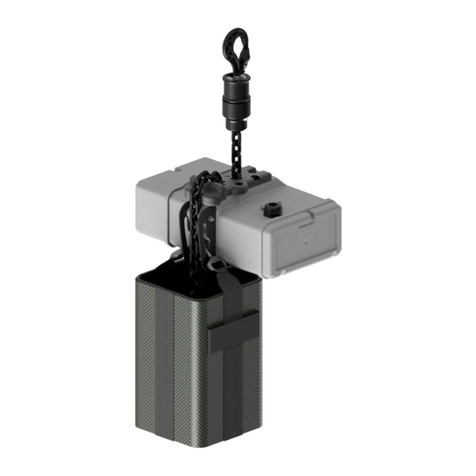3
Table of Contents
1Safety advice...............................................................................................................................................5
1.1 Regulations..................................................................................................................................................5
1.2 Proper use of electric chain hoists...............................................................................................................6
1.3 Application conditions..................................................................................................................................6
1.4 Prohibitions for use......................................................................................................................................7
1.5 Operating instructions..................................................................................................................................7
1.6Spare parts..................................................................................................................................................7
2Technical overview......................................................................................................................................8
2.1 Assembly possibilities..................................................................................................................................8
2.2 Fitting the load chain....................................................................................................................................8
2.3Sectional view..............................................................................................................................................9
2.4 Explanation of type designation...................................................................................................................9
3Transportation and storage........................................................................................................................10
3.1 Transportation ...........................................................................................................................................10
3.2 Storage......................................................................................................................................................10
4Assembly...................................................................................................................................................11
4.1 Mechanical assembly ................................................................................................................................11
4.1.1 Hook tackle................................................................................................................................................11
4.1.2 Hook block.................................................................................................................................................11
4.1.3 Stationary suspension ...............................................................................................................................12
4.1.3.1 Suspension with suspension eye...............................................................................................................12
4.1.3.2 Suspension with single hole suspension eye.............................................................................................13
4.1.3.3 Suspension with suspension hook.............................................................................................................15
4.1.4 Hoisting gear with electric trolley ...............................................................................................................17
4.1.4.1 Mechanical assembly ................................................................................................................................17
4.1.4.2 Electric connection of trolleys ....................................................................................................................18
4.1.4.3 Electric control of the brake.......................................................................................................................18
4.1.5 Chain box ..................................................................................................................................................19
4.1.5.1 Mounting the chain box..............................................................................................................................19
4.1.5.2 Oversize chain box....................................................................................................................................20
4.1.6 Lift limiter...................................................................................................................................................21
4.1.7 Gear ventilation..........................................................................................................................................21
4.1.8 Schematic sketch of the load chain configuration - single fall version .......................................................22
4.1.9 Schematic sketch of the load chain configuration - double fall version......................................................23
4.1.10 Replacing the load chain, the chain guide and the chain hold-down.........................................................24
4.1.10.1 Single fall operation...................................................................................................................................24
4.1.10.2 Double fall operation..................................................................................................................................25
4.2 Electric connections...................................................................................................................................26
4.2.1 Mains connection.......................................................................................................................................26
4.2.2 Low voltage control....................................................................................................................................27
4.2.3 Electric control of the hoist brake...............................................................................................................27
4.2.4 Electric limit switch.....................................................................................................................................27
4.2.4.1 Location of electric limit switches...............................................................................................................27
4.2.4.2 Disassembling and assembling the limit switch shaft ................................................................................28
5Operation...................................................................................................................................................29
5.1 Control pendant.........................................................................................................................................29
5.2 Radio remote control .................................................................................................................................30
5.3 Load slinging .............................................................................................................................................30
6First use.....................................................................................................................................................31
6.1 General conditions and prerequisites ........................................................................................................31
6.2 Inspection before first use..........................................................................................................................31
6.3 Inspection at first use.................................................................................................................................31
6.3.1 Inspection contents....................................................................................................................................31
6.3.2 Conducting the investigation......................................................................................................................32





























